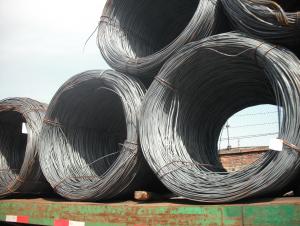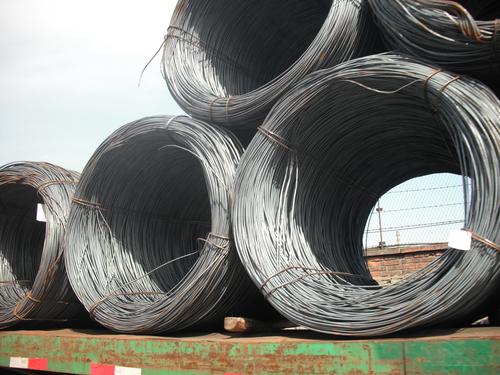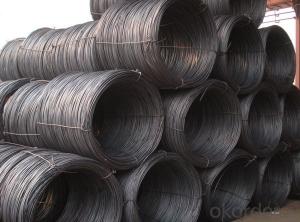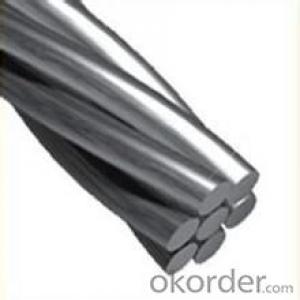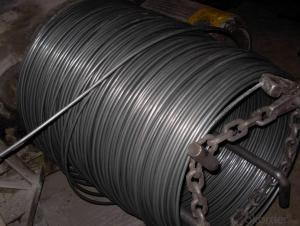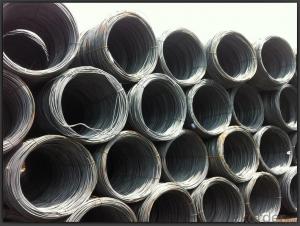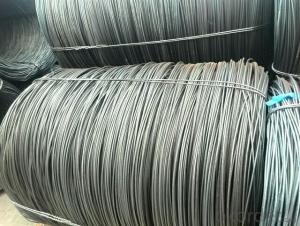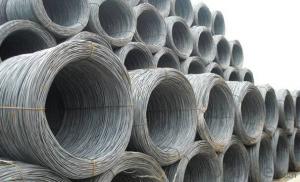Hot Rolled Steel Wire Rod SAE1008B
- Loading Port:
- China Main Port
- Payment Terms:
- TT or LC
- Min Order Qty:
- -
- Supply Capability:
- -
OKorder Service Pledge
OKorder Financial Service
You Might Also Like
Product Description:
OKorder is offering Wire Rod at great prices with worldwide shipping. Our supplier is a world-class manufacturer of steel, with our products utilized the world over. OKorder annually supplies products to European, North American and Asian markets. We provide quotations within 24 hours of receiving an inquiry and guarantee competitive prices.
Product Applications:
After hot-rolled the products shaped into coil and delivery as finished product, including round, square, rectangular, hexagonal and so on. Since most of the products are round, it is generally called wire rod. Carbon steel wire rod is widely used in construction and manufacturing. Carbon steel wire rod is mainly used for reinforcement of reinforced concrete and welded structure or reprocessed (roberts , nail, etc.) materials, especially used to produce wire drawing, welding electrode, nails, spring, electronic, precise machinery parts and so on.
Product Advantages:
OKorder's Wire Rod are durable, strong, and resist corrosion.
Main Product Features:
· Premium quality
· Prompt delivery & seaworthy packing (30 days after receiving deposit)
· Corrosion resistance
· Can be recycled and reused
· Mill test certification
· Professional Service
· Competitive pricing
Product Specifications:
Steel Grade: Q195/235, SAE1006-1018B Standard: ASTM, GB
Diameter: 5.5mm, 6.5mm, 7mm,8mm,9mm,10mm,12mm,14mm
Type: in coil, coil weight around 2MT Alloy or Not: Alloy
Surface: round, no twisted, light and smooth Chemical Composition: (Please kindly find our chemistry of our material based on Q195、Q235A and Q235B as below for your information)
Grade | Chemical Composition (%) | |||||
C | Mn | S | P | Si | B | |
SAE1008B | 0.10max | 0.32max | 0.045max | 0.040max | 0.30max | 0.0008min |
Mechanical properties | ||||||
Yield strength(N/mm2) | Tensile strength(N/mm2) | Elongation (%) | ||||
≥195 | 350-380 | ≥32 | ||||
FAQ:
Q1: Why buy Materials & Equipment from OKorder.com?
A1: All products offered byOKorder.com are carefully selected from China's most reliable manufacturing enterprises. Through its ISO certifications, OKorder.com adheres to the highest standards and a commitment to supply chain safety and customer satisfaction.
Q2: How do we guarantee the quality of our products?
A2: We have established an advanced quality management system which conducts strict quality tests at every step, from raw materials to the final product. At the same time, we provide extensive follow-up service assurances as required.
Q3: Can stainless steel rust?
A3: Stainless does not "rust" as you think of regular steel rusting with a red oxide on the surface that flakes off. If you see red rust it is probably due to some iron particles that have contaminated the surface of the stainless steel and it is these iron particles that are rusting. Look at the source of the rusting and see if you can remove it from the surface.
Images:
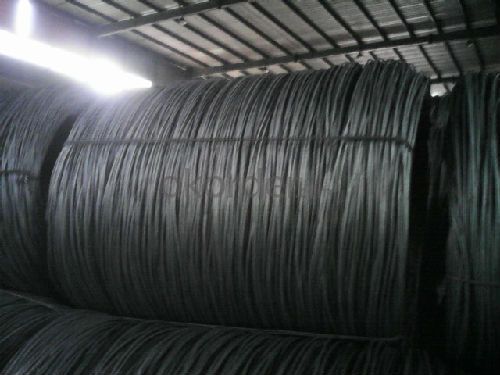

- Q: What are the different types of steel wire rod wire drawing lubricants?
- There are various types of steel wire rod wire drawing lubricants, including dry lubricants, oil-based lubricants, and water-based lubricants. Dry lubricants are typically a mixture of graphite and other solid lubricants, which reduce friction during the wire drawing process. Oil-based lubricants are formulated with mineral or synthetic oils, providing excellent lubricity and reducing heat generation. Water-based lubricants are composed of water and additives like emulsifiers, rust inhibitors, and lubricating agents, offering good cooling and lubrication properties during wire drawing.
- Q: How are steel wire rods used in the manufacturing of bicycle spokes?
- Steel wire rods are used in the manufacturing of bicycle spokes by being drawn through a series of dies to achieve the desired diameter and strength. These rods are then cut into lengths, threaded at both ends, and attached to the bicycle hub and rim, providing the necessary support and tension to the wheel.
- Q: How is steel wire rod used in the manufacturing of wire for oil and gas pipelines?
- Steel wire rod is a crucial component in the manufacturing process of wire used for oil and gas pipelines. It serves as the primary raw material for wire production due to its strength, durability, and ability to withstand extreme conditions. The manufacturing process starts with the selection of high-quality steel wire rod, which typically consists of low carbon steel or alloy steel. This raw material is carefully chosen to meet specific requirements such as strength, corrosion resistance, and flexibility. The steel wire rod is then subjected to a series of manufacturing processes, including cleaning, descaling, and surface preparation. These steps ensure that any impurities or contaminants are removed, resulting in a clean and uniform surface. Next, the steel wire rod is heated to a specific temperature and passed through a series of dies to reduce its diameter. This process is known as drawing and is repeated several times until the desired wire diameter is achieved. The drawing process also imparts the wire with increased strength and improved mechanical properties. After drawing, the wire is annealed to relieve internal stresses and enhance its ductility. This step involves heating the wire to a specific temperature and then cooling it slowly, resulting in a more flexible and workable material. Once the wire is annealed, it undergoes another cleaning process to remove any residue or impurities that may have accumulated during manufacturing. The wire is then coated with a protective layer to enhance its corrosion resistance, typically through processes such as galvanization or polymer coating. Finally, the wire is spooled onto large reels, ready for further processing or direct use in the manufacturing of oil and gas pipelines. The wire is carefully inspected for quality, ensuring that it meets the required specifications and standards for use in these critical applications. In the manufacturing of oil and gas pipelines, the wire produced from steel wire rod plays a vital role. It is used in various applications such as reinforcement, binding, or as a structural component. The high strength and durability of the wire ensure that the pipelines can withstand the harsh operating conditions, including high pressure, extreme temperatures, and corrosive environments. Overall, steel wire rod serves as the foundation for the manufacturing of wire used in oil and gas pipelines. Its properties of strength, durability, and ability to withstand harsh conditions make it an essential material for ensuring the reliability and longevity of these critical infrastructure components.
- Q: What are the different surface cleaning methods for steel wire rod?
- Steel wire rods can be cleaned using various methods to eliminate impurities and enhance their quality. Some of these methods include mechanical cleaning, chemical cleaning, electrochemical cleaning, ultrasonic cleaning, and steam cleaning. Mechanical cleaning involves using mechanical abrasion, such as wire brushing, sanding, or shot blasting, to eliminate surface impurities like rust or loose particles. Chemical cleaning, on the other hand, utilizes chemicals to dissolve or react with contaminants. Acid pickling is commonly used to remove oxide layers or scale, while alkaline cleaning can eliminate organic impurities. Electrochemical cleaning employs an electrical current, electrolyte solution, and electrochemical pickling or electrocleaning processes to dissolve or dislodge impurities. It is particularly suitable for stainless steel wire rods to maintain their corrosion resistance. Ultrasonic cleaning relies on high-frequency sound waves to create microscopic bubbles that implode on the wire rod's surface, effectively removing contaminants like oils or greases. Steam cleaning employs high-pressure steam to dislodge and eliminate contaminants, making it useful for heavily contaminated wire rods. It is important to consider factors such as the type and severity of contamination, desired cleanliness level, and specific end application requirements when selecting a cleaning method for steel wire rods. Each method has its own advantages and limitations, so choosing the most appropriate one is vital to ensure the highest quality and performance of the wire rod.
- Q: What are the main factors influencing the choice of steel wire rod order lead time?
- The main factors influencing the choice of steel wire rod order lead time include market demand and availability, production capacity, transportation logistics, supplier lead times, and customer preferences.
- Q: How does the dimensional accuracy of steel wire rod vary with different heat treatment processes?
- The dimensional accuracy of steel wire rod can vary with different heat treatment processes. Heat treatment processes, such as annealing or quenching and tempering, can affect the microstructure and mechanical properties of the steel wire rod. The dimensional accuracy can be influenced by factors like the cooling rate, the temperature and duration of the heat treatment, and the composition of the steel. Generally, controlled heat treatments can help improve the dimensional accuracy of the steel wire rod by reducing internal stresses and ensuring uniformity in the material.
- Q: How is steel wire rod used in the production of wire ropes for marine applications?
- The production of wire ropes for marine applications relies heavily on steel wire rod. Wire ropes, which serve various purposes in the marine industry such as mooring, towing, lifting, and rigging operations, are manufactured using steel wire rod made from high carbon steel. To create the final product, the wire rod undergoes a series of processes. Initially, the wire rod is drawn through dies, reducing its diameter and increasing its length. This wire drawing process is necessary to achieve the desired size and strength of the wire rope. After wire drawing, a lubricant is applied to the wire to improve its corrosion resistance and reduce friction during subsequent processes. The lubricated wire is then twisted together with other wires to form strands. These strands are helically laid around a core wire to create the wire rope. The core wire can be made of steel or a synthetic material, depending on the specific requirements of the application. The quality of the steel wire rod used directly impacts the strength and durability of the wire rope. The high carbon content in the wire rod provides the necessary strength and load-bearing capacity for marine applications. Additionally, the wire rod's resistance to corrosion is crucial in ensuring the longevity and reliability of the wire rope in harsh marine environments. Furthermore, the mechanical properties of the wire rod, such as tensile strength and ductility, play a significant role in determining the performance of the wire rope. These properties enable the wire rope to withstand heavy loads, resist deformation, and endure the dynamic forces encountered during marine operations. In conclusion, steel wire rod is a crucial component in the production of wire ropes for marine applications. Its high strength, corrosion resistance, and mechanical properties make it an ideal raw material for manufacturing wire ropes capable of withstanding the demanding conditions of the marine industry.
- Q: How is the brittleness of steel wire rod determined?
- The brittleness of steel wire rod is determined through various methods and tests. One commonly used test is the Charpy impact test, which measures the energy required to fracture a notched sample of the wire rod. This test helps determine the material's resistance to sudden impact or shock loading. Another method is the tensile test, which measures the wire rod's ability to withstand stretching or pulling forces until it fractures. The test involves applying a gradually increasing load to the wire rod until it breaks, allowing for the determination of its ultimate tensile strength and elongation. Furthermore, hardness tests such as the Rockwell or Vickers hardness tests are conducted to measure the wire rod's resistance to indentation or penetration by a standardized indenter. A higher hardness value indicates a greater resistance to deformation and potentially lower brittleness. Additionally, microstructural analysis techniques like optical microscopy or scanning electron microscopy (SEM) can be employed to examine the internal structure of the wire rod. The presence of certain microstructural features, such as large grain boundaries or the presence of impurities, can indicate higher brittleness. Overall, a combination of mechanical tests, hardness measurements, and microstructural analysis helps determine the brittleness of steel wire rod and enables manufacturers to assess its suitability for specific applications.
- Q: How is the wear resistance of steel wire rod assessed?
- Assessing the wear resistance of steel wire rod can be done using various methods. One commonly used approach involves conducting the pin-on-disk test. In this test, a steel pin is pressed against a rotating disk made of a different material. The amount of wear experienced by the steel pin is then determined by measuring the weight loss or volume loss after a certain number of rotations. Another method, known as the abrasion test, entails rubbing the steel wire rod against a rough surface and measuring the resulting wear. Furthermore, evaluating the wear resistance of the steel wire rod can also be achieved by subjecting it to realistic conditions, such as within a machine or equipment, and observing its performance over time. These methods serve to gauge the steel wire rod's ability to endure wear and offer invaluable insights for the development and enhancement of products.
- Q: How is the surface quality of steel wire rod assessed?
- The surface quality of steel wire rods is assessed through various methods and criteria. One of the primary parameters used to evaluate the surface quality is the presence of defects such as cracks, scratches, pits, or scale. These defects can significantly affect the performance and reliability of the wire rod. Visual inspection is the initial step in assessing the surface quality. Skilled operators examine the wire rods for any visible defects using proper lighting and magnification tools. This method allows for the detection of larger defects that may affect the wire rod's strength and appearance. Another important technique is non-destructive testing (NDT), which includes methods like ultrasonic testing, eddy current testing, and magnetic particle inspection. These methods help identify internal defects that may not be visible to the naked eye. Ultrasonic testing utilizes high-frequency sound waves to detect internal cracks or voids. Eddy current testing uses electromagnetic induction to evaluate the conductivity and surface condition of the wire rod. Magnetic particle inspection involves applying magnetic particles to the surface of the wire rod, which then reveals any defects by forming visible indications. In addition to these methods, dimensional checks are performed to ensure the wire rod meets the required specifications. This includes measuring parameters such as diameter, roundness, and straightness. Any deviations from the specified dimensions can indicate surface irregularities. Overall, the assessment of surface quality in steel wire rods involves a combination of visual inspection, non-destructive testing, and dimensional checks. By employing these techniques, manufacturers can ensure that the wire rods meet the required quality standards and are suitable for various applications such as automotive components, construction materials, and electrical wires.
Send your message to us
Hot Rolled Steel Wire Rod SAE1008B
- Loading Port:
- China Main Port
- Payment Terms:
- TT or LC
- Min Order Qty:
- -
- Supply Capability:
- -
OKorder Service Pledge
OKorder Financial Service
Similar products
Hot products
Hot Searches
Related keywords
